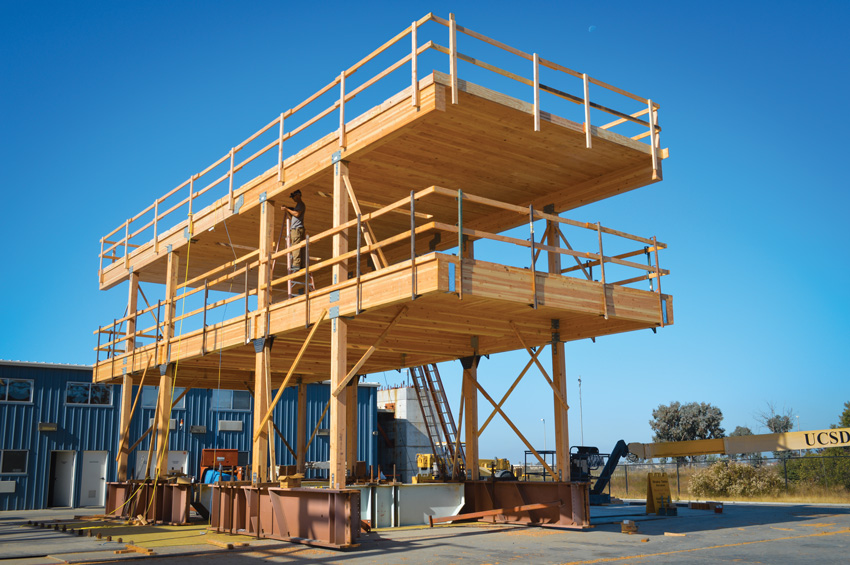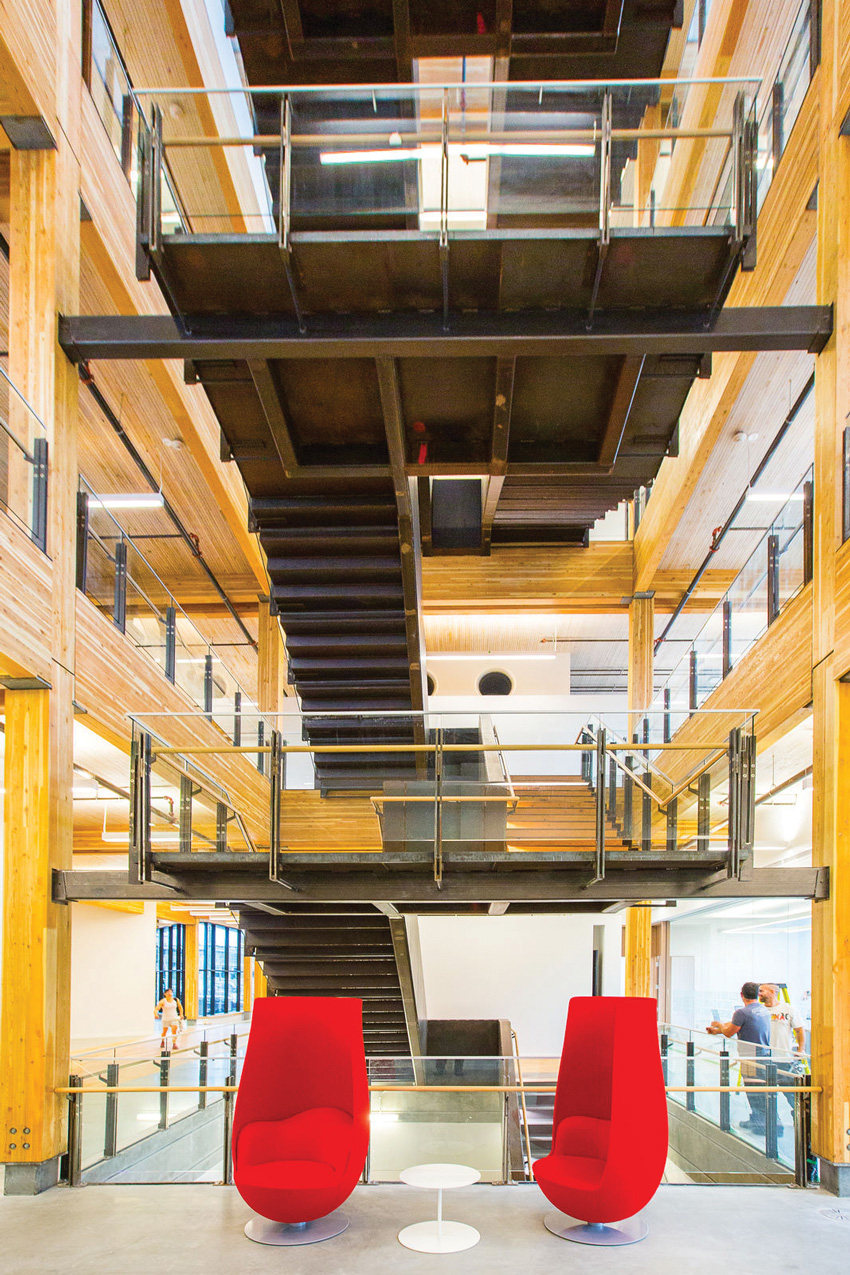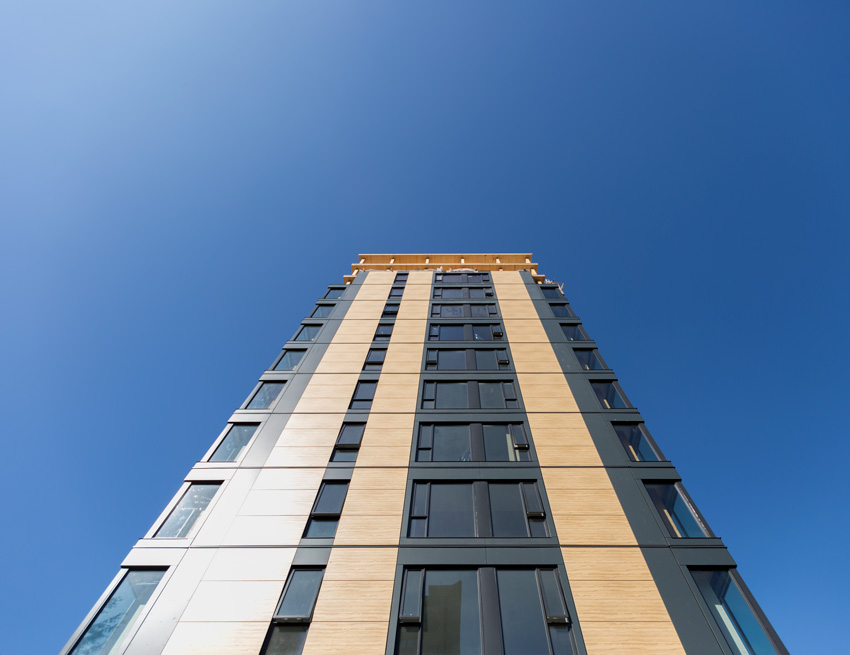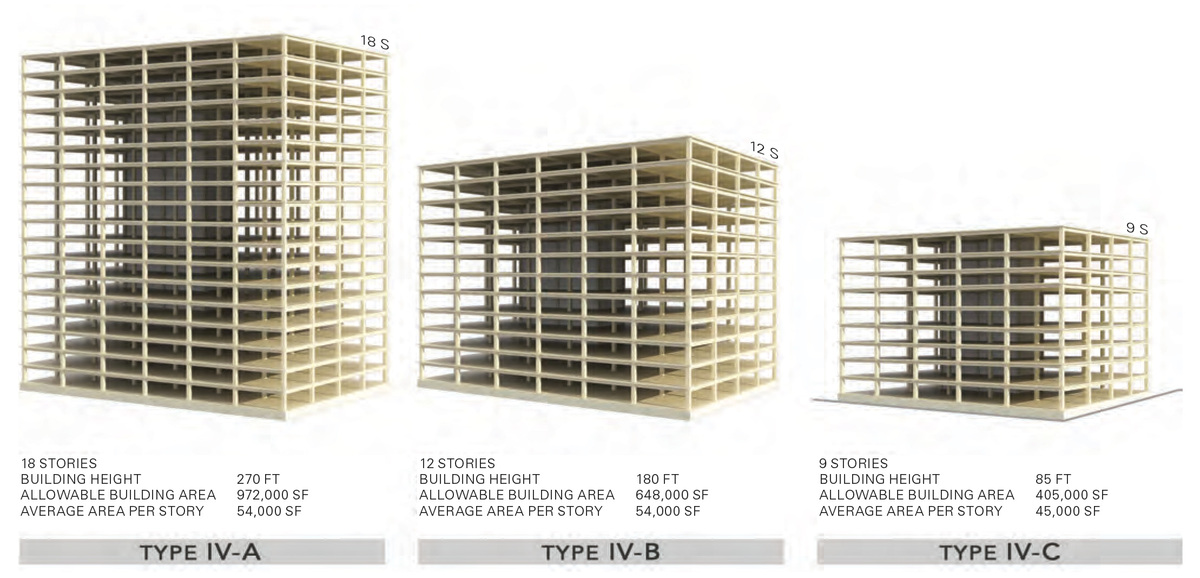Wood and Evolving Codes: The 2018 IBC and Emerging Wood Technologies
Seismic Performance
Years of research and building code development have proven that wood-frame and hybrid structures can meet or exceed the most demanding earthquake design requirements.
Most earthquake damage is caused by seismic waves that force the ground to move and cause the building foundation to shake. Forces generated in an earthquake are proportional to the structure’s weight. Thus, the overall magnitude of earthquake-induced forces that a building must resist is generally less for lighter buildings—and wood is substantially lighter than other common building materials. The fact that wood buildings tend to have numerous connections means they have more load paths, and there is less chance the structure will collapse should some connections fail. These many connections also give wood buildings inherent ductility.
The correct design of elements such as frames, shear walls, diaphragms, and their connections to each other is of utmost importance as earthquake forces “search out” the weak links between structural members. Post-earthquake investigations conducted by the Federal Emergency Management Agency (FEMA) have shown that a large proportion of the serious earthquake damage to modern structures is not linked to design deficiencies, but rather occurred “because contractors did not construct structural elements and nonstructural components as required in the design drawings and specifications.”5
A report on damage to wood-framed buildings in Southern California earthquakes shows that wood-framed structures, including single-family homes, generally perform well during seismic events.6 An inspection of schools after the 1994 Northridge earthquake revealed that overall, the facilities fared very well, with most of the damage consisting of nonstructural or structural but repairable damage.7
More recently, shake table testing has verified the favorable seismic performance observations of wood-framed buildings.8 For these tests, both light-frame and CLT buildings were subjected to earthquake simulations while sensors measured factors such as displacement distance between components and the degree of bending of building elements. In particular, shake table tests are showing multistory buildings made with CLT perform very well, just like their light-frame predecessors. One seven-story building that was tested on a shake table in Japan survived 14 earthquake simulations with minimal damage.9
The University of California San Diego has also been conducting extensive shake table testing on a variety of buildings, studying everything from base isolation to the effect of earthquakes on nonstructural components to fire spread. In particular, researchers are conducting tests in order to develop and validate a seismic design methodology for eight- to 20-story tall mass timber buildings. A two-story CLT building has been tested using a rocking wall system that enables CLT walls to counter lateral loads, and the research team plans to build and test a 10-story CLT building by 2020. The results of these and other tests will continue to inform building code provisions.10

Photo courtesy of UCSD Jacobs School of Engineering
Shake table testing exposes full-scale buildings to simulated seismic events.
Wind Resistance
In addition to superior seismic performance, wood buildings can be designed to effectively resist high winds. Wood’s elastic limit and ultimate strength are higher when loads are applied for a shorter time period, which is typically the case in high wind events. When wood structural panels such as plywood or OSB are properly attached to lumber framing and used to form diaphragms and shear walls, they also form some of the most solid and stable roof, floor, and wall systems available. However, in order for the diaphragms and shear walls to be effective, all of the related components—including framing, structural panel sheathing, and inter-element fastening details—must be designed and installed correctly. The success of the entire system depends on the quality and quantity of the connections, which transfer loads through the building to the foundation, and ultimately, to the ground.
The loss of inadequately connected roofing materials and sheathing is a leading cause of failure in wood-frame buildings during high-wind events.11 Once the roof sheathing has been pulled off its framing, the load path is interrupted and the diaphragm ceases to function as part of the lateral load-resisting system.12 In fact, the entire loading dynamics of the building will have changed due to this breach. This change in loading dynamics negatively affects the lateral design of the building.
Surveys of wood-framed buildings following Hurricane Katrina revealed that “failure to construct to prevailing building codes” contributed to a significant portion of the damage. The surveys revealed the following fatal flaws: improper or inadequate fastening of roof sheathing to rafters, failure to provide an adequate load path from roof to wall or wall to foundation, and improper installation of shingles (not enough fasteners and/or inadequate spacing of fasteners).11 In many cases, these shortcomings led to total building loss.
Major disasters often lead to significant code changes. Following Hurricane Andrew, which struck Florida in 1992, damage assessment teams found roof sheathing panels with as few as four fasteners. This event inspired the creation of the Florida Building Code. A FEMA Mitigation Assessment Team (MAT) report following the 2004 hurricane season in Florida showed that new homes built to the 2001 Florida Building Code performed well, even when subjected to winds as high as 150 miles per hour. This was in part due to adequate connection of the roof deck to trusses and rafters.12
With proper detailing, it is relatively easy to meet code requirements for safety during high wind and seismic events. The AWC’s Special Design Provisions for Wind and Seismic (SDPWS) is directly referenced by the IBC for the required design of lateral force-resisting systems, such as nailed wood-frame shear walls and diaphragms that resist lateral loads.
Sound Transmission and Acoustics
Wood offers excellent acoustic control; hence it can be used to enhance and/or mitigate sound. In residential buildings, IBC 2018 provides a minimum design requirement for unit-to-unit acoustical protection between floors. It requires a sound transmission class (STC) rating and impact insulation class (IIC) rating of 50. STC describes how effective a wall or floor/ceiling assembly is at blocking airborne sound transmission from one room to the next. IIC describes how effective a floor/ceiling assembly is at blocking structure-borne noise created by impacts on a floor through a ceiling to the room below. The higher the number, the more effectively sound is blocked. Wood buildings can be designed to meet or exceed minimum sound transmission requirements depending on the expectations of the developer, buyers, and tenants. Designers sometimes aim for ratings higher than those required by code, particularly for luxury multifamily units.
Wood-frame construction is particularly efficient in residential buildings where sound insulation is required. Attaching gypsum board to walls and ceilings using resilient metal channels significantly reduces sound transmission, as does placing glass-fiber or rock-fiber insulation within wood-frame floor and wall assemblies.13 Wood does provide a “bridge” for sound; consequently, constructions which provide thermal breaks, such as staggered-stud and double-stud construction, are more effective at blocking sound than conventional single-stud construction. In this case, using “resilient connections” can improve acoustic performance. These systems, which include fiberboard sheathing systems, special metal channels, and vibration isolators, convert sound waves into mechanical energy so that less sound is transmitted through the assembly.13
The Evolution of Wood Construction
Wood construction can be divided into three major categories. Light-frame construction, which dominates the residential home industry, consists of many lightweight framing members that are typically nailed together and spaced closely. Post-and-beam construction consists of decking and heavier posts and beams which create a “skeleton” for the building. Compared to the studs in light-frame building, the posts are spaced relatively far apart. Mass timber construction is characterized by the use of heavy timber or engineered panels which form the structural members for the floor, roof, and walls.
In recent years, designers have embraced wood construction for many types of buildings, thanks to innovative and inspiring examples and updates to the building code which have made more uses possible.
Mid-rise and Multifamily
Often used in multifamily projects, podium construction consists of multiple stories of light framing built over a single- or multistory podium of another construction style, usually concrete. Increasingly, developers are turning to wood for their multifamily projects because of the material’s cost performance, environmental footprint, and speed of construction.14
The use of concrete-and-steel podiums allows light-frame construction to be used for mid-rise buildings, and updates in the 2015 IBC (which are unchanged in the 2018 IBC) allow for multistory podiums, making it easier to design multiuse buildings with ground-floor retail.15 Mid-rise buildings are typically categorized as Type V Construction, which allows the use of untreated wood throughout, or Type III Construction. Type III Construction allows the same methods of construction as Type V, except the exterior walls are required to be of noncombustible construction. This allows the use of fire-retardant-treated wood. Many developers and design teams default to wood for mid-rise buildings up to four stories because it is the most economical choice;16 however, with five-story wood buildings permitted in the IBC (six for office occupancy), there has been a marked interest among those who see taller wood buildings as a way to achieve greater density at lower cost. Podium structures in particular, which include multiple stories of residential wood-frame construction over a concrete (3-hour-rated) podium deck, are common among design professionals seeking to incorporate parking, retail, or restaurants into their designs. The specific requirements for using podium construction to increase allowable number of stories are detailed in Section 510 of the IBC.
Schools
The IBC has well-established parameters for light wood-frame schools, which is good news for school districts trying to accommodate increasing enrollment. Accordingly, many who turn to wood-frame construction find that wood offers advantages, such as speed of construction, design versatility, and the ability to meet green building goals. Increasingly, research is also supporting the idea that visual wood in a room promotes the well-being of occupants, reduces stress, and creates a positive environment for learning.
For institutes of higher education, new buildings also provide opportunities to showcase innovative technologies, some of which have been developed at the institutions themselves. For example, the John W. Oliver Design Building, located on the University of Massachusetts, Amherst campus, is one of the first institutional buildings in the Northeast to utilize a mass timber structure. Completed in 2017, the Design Building features an exposed glulam frame, CLT and concrete composite floors, and CLT elevator, stair, and mechanical shafts. A grand CLT stair is also a central focus of the atrium. The UMass Building and Construction Technology program developed some of the CLT technology used in the building, which is already being recognized as a groundbreaking “green” building. Some of its other features include LED lighting paired with optimized daylighting, heat recovery systems, and sustainable landscaping features such as bioswales and raingardens.
Productivity and Health
Wood is a particularly good choice for health-care facilities, especially if the material is left exposed, as it can help buildings feel less institutional and even contribute to healing environments. This idea is backed by research studies which have shown that patients recover more quickly when exposed to “natural” materials and views of nature, and that workers are more productive in so-called “biophilic” settings—those characterized by natural light, natural materials, and views.18
As a case in point, the Herrington Recovery Center is a 21,000-square-foot, 20-bed wood-frame treatment center in Oconomowoc, Wisconsin. The building features cedar and stained wood both inside and outside. Wood ceilings and soffits add warmth to the recreation and sleeping rooms. Exposed glulam beams allow for soaring ceilings, clerestory windows provide natural light, and wood floor systems create a comfortable surface underfoot. In addition to contributing to a warm and healing environment, the use of wood saved both time and money.
The Mountain Equipment Co-op (MEC) headquarters building in Vancouver, British Columbia, illustrates how wood can be used to achieve multiple benefits, including structural integrity and seismic and fire safety, along with environmental and health benefits. The 112,000-square-foot building is a hybrid timber and steel structure which includes floor assemblies made with prefabricated NLT panels. Laminated timber beams and columns are exposed within the building, and an open floorplan and generous glazing bring in natural light and highlight the warmth and beauty of the exposed wood elements. This “natural setting” contributes to the health and well-being of MEC employees and makes the building a pleasant and productive place in which to work.

Photo courtesy of KK Law + naturallywood.com
The MEC headquarters building in Vancouver, British Columbia, features an open plan and lots of exposed wood, which contributes to the health and well-being of employees.
Tall Wood Buildings
A 2017 audit on tall mass timber buildings summarizes the plethora of new projects that are either built, under construction, or in the planning stages all around the world, and graphically demonstrates the rising trend of wood buildings that are greater than six stories.
Several wood and wood hybrid buildings are underway or have been recently completed in Canada. For a short time, the 97-foot-tall Wood Innovation Design Center, completed in 2014, was the largest all-timber building in the world. The Arbora complex in Montreal consists of three eight-story, all-timber buildings and integrates housing units with retail in an “urban forest” setting. Brock Commons Tallwood House, a hybrid timber and concrete student dormitory at the University of British Columbia in Vancouver, was just completed. The 18-story building currently holds the record for the world’s tallest mass timber building.
Though lagging behind Canada and Europe, mass timber is starting to make inroads in the United States. These include a range of multifamily structures, office buildings, and educational projects such as the Design Building at UMass described earlier. In Minneapolis, an all-timber, seven-story office building called T3 was completed in 2016. T3 was constructed with NLT panels combined with a spruce glulam post-and-beam frame and a concrete slab. Carbon12, an eight-story residential building in Portland is breaking ground with performance-based testing. This building’s design includes a “buckling-restrained braced frame core” surrounded by a timber and CLT structure.

Photo credit: Brudder Productions + naturallywood.com
Featuring a hybrid mass-timber system, Brock Commons demonstrates the application of mass timber in high-rise construction.
Tall Mass Timber Updates in the 2021 Code
In January 2019, the International Code Council (ICC) approved a set of proposals to allow tall wood buildings as part of the 2021 International Building Code (IBC). Based on these proposals, the 2021 IBC will include three new construction types:
- Type IV-A – Maximum 18 stories, with noncombustible protection on all mass timber elements.
- Type IV-B – Maximum 12 stories, limited-area of exposed mass timber walls and ceilings allowed.
- Type IV-C – Maximum 9 stories, all mass timber permitted to be exposed (with a few exceptions e.g. shafts) and designed for a 2-hour fire resistance.

Photo courtesy of atelierjones, LLC
These new types are based on the existing Heavy Timber construction type (renamed Type IV-HT) but with specified hourly fire-resistance ratings for building elements and added levels of noncombustible protection. The code will include provisions for up to 18 stories of Type IV-A construction for Business and Residential Occupancies.
A team of fire experts from the U.S. Bureau of Alcohol, Tobacco, Firearms and Explosives (ATF) working alongside scientists from the U.S. Forest Products Laboratory tested 5 identically furnished, one-bedroom apartments constructed of exposed, partially exposed, and unexposed (protected) five-ply cross-laminated timber (CLT). The rigorous series of fire tests demonstrated that mass timber construction performed equivalent to non-combustible construction and provided valuable data that was used in the development of code change proposals submitted by the ICC Ad Hoc Committee on Tall Wood Buildings (TWB) for the 2021 International Building Code. 17









